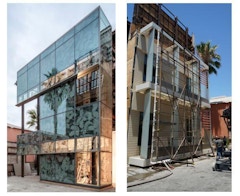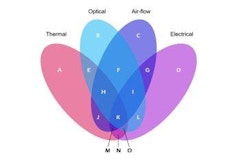
442 results
-
 The real estate market continues to demand “all glass” buildings often to the detriment of human comfort and thermal performance. For an office…
The real estate market continues to demand “all glass” buildings often to the detriment of human comfort and thermal performance. For an office… -

Envelope For Service
- Paper by Annalisa Andaloro · Miren Juaristi · Stefano Avesani · Giulia Santoro · Matteo Orlandi
Envelope-for-Service (E4S) is a novel business model developed with the aim of converting the building façade from a traditionally traded good to a
-

Building Rehab/Reuse, Decarbonization and Modern-Era Precast Facades
- Article by Mark Thompson Brandt, OAA, RAIC, FAPT-RP, LEED AP, CAHP,, Founding Partner
-

Building Innovation 2023 - Call for Abstracts!
- Event by National Institute of Building Sciences (NIBS)
The National Institute of Building Sciences is gearing up for the industry’s only conference for the entire building community to connect, collaborate, and design solutions for the built environment – and we are looking for speakers.
-

Finally
- Paper by Michael Mulhern,
For over 60 years architects, engineers, and consultants have been specifying stainless steels for use in building skins and in some structural… -

FTI DIALOGUES: Collaborative Project Delivery Reloaded
- Article by April Rawson, FTI Special Advisory Council
The Facade Tectonics Institute kicked off their first installment of FTI Dialogues: Suppliers & Contractors Series virtually on Friday, March 19th. High-performance facade systems are recognized as a key element in achieving sustainable building performance while also being tasked with providing
-
Recent Adaptive Textile Façade Systems
- Paper by Lucio Blandini, Director, Full Professor Moon-Young Jeong, Doctoral Researcher Michael Voigt, Doctoral Researcher, IKTD, University of Stuttgart Jonathan Lopez, Doctoral Researcher Hannah Schürmann, Doctoral Researcher Arina Cazan, Research Assistant Hannah Raisch, Student Daniel Roth, Head of Research Group Methodical Product Development, IKTD, University of Stuttgart Maria Matheou, Junior Professor
Adaptive facade systems are a promising approach to achieve a dynamic response to varying weather conditions and user demands. The interdisciplinary… -

Structural Silicone Glazing
- Paper by Jon Kimberlain · Yvonne Diaz · Andrew Dunlap · Adrienne Bowman-Grittini
The recent 50 year anniversary of the first use of silicone sealant in a 4-sided structural silicone glazing application marks a sustainable and
-

DC Water Headquarters Case Study
- Paper by Sven Shockey, Leland Curtis, David Fersh,
Facades must be responsive to a myriad of qualities and influences ranging from urban impact and aesthetic character to numerous performance… -

The Facade and Energy Codes
- Paper by Elliot Glassman
Ever-increasing performance requirements in the latest version of the energy codes are compelling project teams to consider the thermal performance
-
Transitions Between Diverse Envelope Systems
- Paper by Kristian Fosholt, LEED AP BD+C · Megan Koehler, AIA, LEED AP BD+C · Andrew Tsay Jacobs, AIA, EIT, LEED AP BD+C
The Lucile Packard Children’s Hospital at Stanford University in Palo Alto, California features an extremely diverse set of facade systems within one
-

Event Passed
–AIA Latin America/ Anahuac University: Fast Forward Architecture Congress
- CDMX, Mexico
Industry Event by AIA Latin America
-

-
Curved Forming Panel Facades
- Paper by Roger Schroeder
The performative and visual aspects of curved forming/bending thin “formable” planar materials is explored. Early tests for deflection indicate that
-

-
Advanced Simulation for Thermal Stress Assessment
- Paper by Andrea Zani, Building Physics and Sustainability Leader Jamie Reyes, Senior Building Physics Engineer Guido Lori, R&D Project Manager Jacob Hanke, Senior Structural Engineer Giacomo Zangiacomi, Building Physics Leader
In recent years, the desire for increased performance, transparency and visual flatness of glazing elements in curtain walls has generated renewed… -

2019 Request for Research concept Briefs
- Announcement
The FTI Research Committee is requesting Research Concept Briefs describing a team and approach for evaluating industry needs and challenges surrounding four key topic areas in which FTI has identified a need to accelerate innovation. The proposed research will clearly identify knowledge gaps and ba
-
Integrated Energy Analysis
- Paper by Greg Verabian · Saurabh Shrestha · Laure Michelon
Energy codes across the country are progressively getting stricter and increasing the threshold for a baseline building’s energy performance.
-
Verifying Thermal Performance
- Paper by Matthew Herman · Mark Walsh
Architects specify curtain wall thermal performance criteria and usually identify simple modeling software, like THERM, to perform thermal analysis
-
Exo-Skins
- Paper by Nick Braaksma · Malini Srivastava, AIA · Chad Ulven
Cost-effective, sustainable, self-actuating, thermally-responsive, bio-composite exo-skins that act like shields or cloaks for existing buildings




